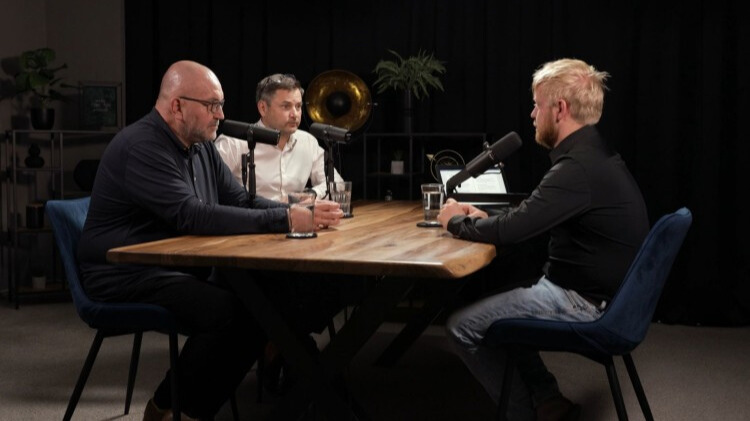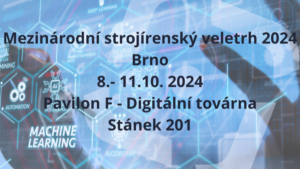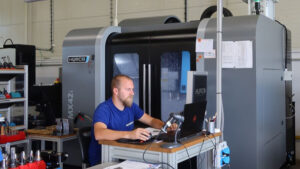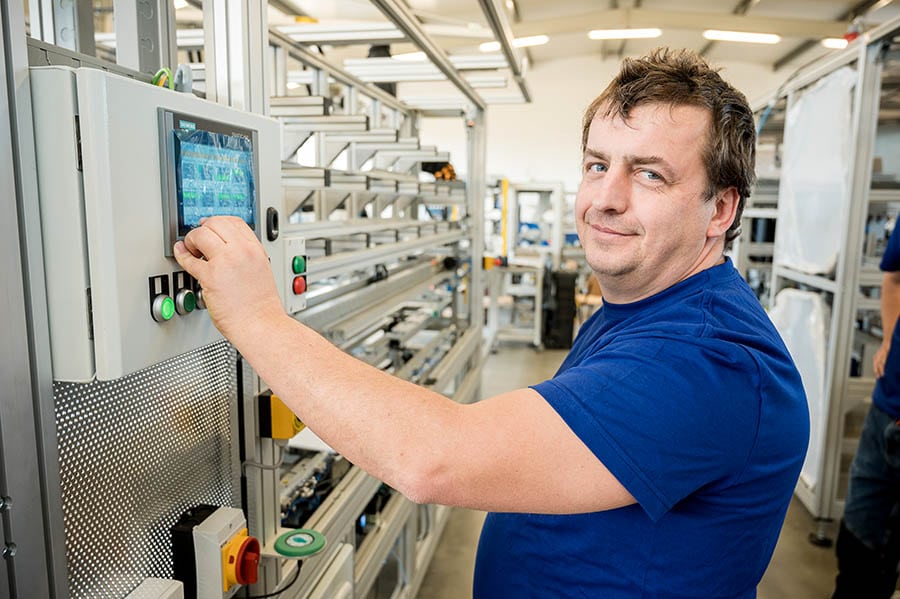They are now representing scorporate colors. Slavoj Musílek represents Central European Automation Holding, which includes, among others, the Czech Automa CZ. Pavel Bezucký currently heads Schneider Electric in the Czech Republic.
If you are interested in the vision of the Czech industry towards automation, robotization, and digitalization, this line-up in the All About Industry podcast studio can undoubtedly offer it!
You've had robotics nicely written on your resume for several years with UR on your jersey, even though you currently hold other company positions. How do you see the robotics trend, which seems to rise constantly now? Do you agree?
PB: I agree. Robotics is a big part of industrial automation, which again will be here with us and needs to be here for the industry to be competitive in some way. So, robotics needs to be on the rise.
SM: I also agree. As you mentioned, we have built a UR business in Central Europe. I would divide robotics into two parts: one that is faster and one that could go faster. Classical industrial robotics runs fast and without question marks, i.e., industrial robots. What's beyond its potential from my point of view is collaborative robots and the use of AGVs, mobile robotics, and those types. We are still behind the market potential or what would help customers save missing labor or bring some added value, etc.
Speaking of market potential, when you stepped out of the company you mentioned, you were still very much connected to the industry world. At Schneider Electric, there's also a range of other technologies; at CEAH, automation is also a keyword. Automation cannot move forward without innovation. Do you see trends that are driving the world of automation or digitalization? What do you see as the key innovation for the Czech industry? Is the potential of automation being exploited in general?
SM: I think we certainly haven't used it. Again, I would divide two areas; the first is the big multinationals, typically automotive, where the development is advanced. But then there are smaller and medium-sized companies and other industries where I think we are still more at the level of thinking about where they could be if all the available approaches or technologies were used or invested in the way they are in automotive.
Pavel Bezucký knows the global figures, and maybe he can help me with a comparison of the Czech market. I've been trying to explain that automation is great for about fifteen years now, but I guess I'm not very good at it... Is it that bad?
PB: I would divide it into traditional and newer automation. Everyone is aware that we need automation. But we have a lot of new technologies and trends, and we don't have enough experts to implement and roll everything out to companies. We also see this in large automotive companies; they used to have their own automation or robotics specialists. Suddenly, they cannot cover many new technologies - collaborative robots, advanced positioning systems, etc. I see this trend as necessary; there must be improvements and simplification of new technologies. That is where I think development will be very much focused.
SM: I wonder if I could add... We are dealing with classic automation, but new technologies are coming in. Artificial Intelligence in industrial use, 5G networks, which may bring a change in the approach to automation - control logic will move to some virtual world, cloud, server solutions, and not "sit" on production equipment as it typically is today. These are massive changes that we need to implement and adopt; we need people who understand them, are passionate about them, and have the conditions created in companies for applying new technologies.
PB: We live in a fast-paced era where standards may be unclear. We have multiple technologies, and everyone is waiting to see which technology, such as wireless communications, will "catch on" as "the" technology.
SM: And the second thing is regulation. Many technologies are hit by the lack of standards that can work with them or standards built on old technologies and are holding back their adoption. If we return to robotics, collaborative robots, AGVs, AMR, etc., the set standards don't allow new technologies. On the other hand, many people in the industry use the limitations of standards and regulations as a reason not to adopt new technologies. It's a vicious circle where I'm unsure how to cut it.
We can go back to cooperative robotics, where there was a discussion about safe/unsafe robots or applications... What are the main barriers to adopting collaborative robots in small and medium-sized companies, and why are companies resisting, even though some growth is seen yearly?
SM: I think the main barriers are in the heads. It's a mix of fear of the initial investment, etc. But I think the main obstacle is people's heads. I keep saying that companies that don't adapt to the trend, i.e., invest in technology that will increase productivity, efficiency, and therefore competitiveness, will, unfortunately, sooner or later perish. It does not matter whether they go to Mongolia or elsewhere to recruit employees. It is a short-term solution that will not keep them in the market.
PB: The professional and less professional automation community perceives robotics as terribly complicated and complex. However, in UR's rendition, collaborative robotics was focused on collaboration and ease of use. When business owners hear the word "robot," they immediately think: Who will program it? How am I going to pay for it? What happens if...? These main mental blocks hinder robotics development in smaller and medium-sized companies.
SM: Today, it is possible to assemble a simple robotic application without deep knowledge of robotics and other related fields. It's just a piece of metal that moves as you tell it. Interestingly, this is not the direction in which development is going anyway. I was also intrigued that many companies were offering robotics as a service, a rental app concept. There, you don't have to have an initial higher investment; you pay for the number of cycles and the monthly rental of the app. That hasn't taken off either. I guess there are a lot of aspects.
Maybe it didn't take off because our market mentality is different. I know from the Control Engineering parent office in the USA that the concept of robot as a service has caught on well there. Are we again referring to that different Central European mentality, i.e., owning things rather than sharing them?
PB: It's hard to say; maybe it's our scepticism about new things and technologies. A group of people always go to try something first - at the level of companies and individuals. But as I see it, the Czech market works more on access: I'll wait a while to see how it takes off elsewhere, and then we'll go for it.
SM: Another feature of Czech nature is that we know best how it should be. It's how it's worked for us for 15, 20, 30 years. We've always had it that way. And it's been that way. There is no appetite for change of thinking, approach, innovation, etc. Because, after all, we're happy with how we've had it. But we are missing the train and may have a problem in two years, so we often don't see that anymore.
I want to come back to one thing that was said. If we talk about the future of automation, Pavel Bezucky mentioned that we need to look for more intelligent and straightforward control of applications. We are seeing a lack of experienced technicians and a lack of interest in technology among the younger generation. So, is simplification a way to cover this deficit?
PB: I don't think it's the only way, but the only way I see. Thirty thousand more people leave the labor market every year than enter it. People will inevitably be missing somewhere, whether they are missing blue-collar or white-collar workers, programmers, operators, robot operators, etc. If the efficiency of people is to increase, a kind of throughput of what they can service, or program has to be easier and faster.
SM: There is one more parameter that comes in. We mention a lack of people, or they are not qualified enough, etc. But the question is whether we are educating those people and they can grow. I'm a bit naive, but I still think that every person can grow, learn something new, progress, and learn new things - the moment they get the opportunity and have some motivation to do so. It's a question, more philosophical, whether people have a chance to go up and learn new things. Automation can help by unburdening people from routine activities and moving them on to something else. People can know and develop in some way. But they must want to learn, push themselves, feel the need, and invest their time or energy. Then I think it can work.
We've mentioned automation several times; what is the primary driver of automation for businesses today? Flexibility, responsiveness to change, finding ways to save money or the path to a greener industry? What is the number one motivation for today's managers and business owners?
SM: Paul may correct me, but I still think it's a labor shortage. Companies cannot produce more, meet customers' needs, and develop their potential because they have too few people. When they don't invest in automation, productivity, or volume increases, and they know they won't have more employees; automation is the only way. The second thing is the flexibility you mentioned. Reacting quickly to market movements, what customers want, etc. That's what pushes automation forward.
PB: Maybe I would add competitiveness because it's closely related. It is directly related to the sufficiency/lack of labor. As our market globalizes, suddenly, Franta from České Budějovice is not only competing with Josef from Strakonice, but he is also competing in the market with someone from China or India. We have to be prepared for that with higher labor prices. We have to be more efficient thanks to automation.
SM: Now I've read interviews with owners of traditional Czech companies. They are thinking about moving production out of the Czech Republic. This is a trend that has been minimal so far. Now, they are openly talking about it.
PB: It's perhaps going against the global market, with big companies pulling production back closer together. Or where the products will be consumed.
SM: But now, when my costs are rising, salaries are rising, or labor costs are rising, the only way I'm able to manage that is by using people at higher wages in a way that they add more value. They can't stand at the belt and bang the screws. They have to do something else. The machines must take over the routine work. Otherwise, it's a vicious cycle.
Speaking of machines, we mention the topic of automation robotization. These are concepts that have been discussed for a long time. Now, Industry 4.0, digitization, has also emerged. What is the correlation between traditional automation and the penetration of new elements today? Is it radically changing the industry as a whole? I read an article that the promised revolution has not only come, but it isn't easy to see the whole trend as an evolution. How do you perceive this from the position of the supplier companies? Thanks to digitalization, are you offering components that are so much smarter than fifteen years ago?
PB: Industry 4.0 is a toolbox for me. A marketing tool is a concept but mainly a set of tools one may or may not use. For me, the huge benefit is the connectivity. In the context of automation, connectivity, remote communication, and the first germs of artificial intelligence through big data are a huge benefit. Why we stop seeing it as a revolution goes hand in hand with the parallel in our daily lives. We have become accustomed to being online all the time. So why would we find it revolutionary with machines or mobile robots?
SM: The change that is finally visibly happening is working with data. Until recently, automation seemed very technological, technical, and machine-based. The change associated with digitization, IoT, and AI is being driven by working with data. We can take data from the manufacturing process and work intelligently with it to optimize, increase efficiency, maximize manufacturing tools, energy consumption, etc. A shift is happening, whether it is fast enough or going very slow and conservative.
You represent companies that supply solutions to companies. Is it possible today to provide "pure" automation without digitalization, or are they such interconnected vessels that they cannot function without each other?
SM: Delivering a complete solution, including data overlay and handling, is essential. Not all customers want that, which goes back to whether we are taking full advantage of today's capabilities. It's not two separate worlds anymore; it's all in one bag.
PB: But we often find that when customers " open up to the world," they become vulnerable. The world of OT, automation, machinery and equipment, and IT departments collide.
Cybersecurity is a big topic today; companies are often not sufficiently secure. On the contrary, it's the last thing they invest in - either because of the cost or the fact that there is no one to address the topic. Do you see it the same way? Threats are increasing, and perhaps the only way to get companies to address cyber security is for them to lose something... Are you closer to your customers? Is that my assumption?
SM: I think it's company by company. For the ones we work with, what's a little bit lacking is some education-building awareness of what cybersecurity is. For many people, the definition comes down to having a computer update done, not clicking on links, having firewalls set up, and having weird messages automatically drop into spam on the mail server. That's just a speck in the whole mosaic. I think many cybersecurity people, even those who should be responsible in companies, don't know how to grasp the subject. There's a lot of talk about cybersecurity, but it doesn't have concrete content for many people.
PB: I don't want to oversimplify this in any way, but I do see a correlation between the size of a company and its approach to cybersecurity. From experience, the more extensive the company, the greater the IT and cybersecurity expertise. Paradoxically, this has translated into situations where they have deliberately boycotted technologies that could have helped the firm. This is one of the things that slows down the push for IoT benefits.
I have another more prominent topic that revolves around automation and digitalization. That is sustainability. Schneider Electric has set itself the goal of going down this path in collaboration with clients and its offerings. Is there a sustainability journey that you perceive is needed? How does the Czech market perceive it? I talked with you about this a few years ago, and I remember that digitalization could accelerate this sustainability. Still, the question is whether Czech companies are willing to follow a similar path. Where has the topic moved? Does the offer of modern tools and digitalization help?
PB: I wouldn't say it's because of the modern tools on offer or the digitalization. What has opened everyone's eyes is the rising energy prices. When we think of sustainability as reducing carbon footprint or energy and put an equation to how much what costs, suddenly everyone starts to meet the parameters of sustainability. The primary motivation does not come from conviction, and I certainly don't want to hurt companies because many of them have so-called green goals. But what started the focus on sustainability is the economic benefits.
SM: Economic benefits for sure, and that's where regulation comes in. Processes and requirements are set by making sustainability a vital and a "push" topic. Sooner or later, companies interested in staying in the market, being competitive, and having access to financing or various collaborations are pushed to meet the emerging criteria.
PB: We, as a company, are very committed to sustainability, not only in promotion. Our factory in Písek is carbon neutral, and it's interesting to see its effect on automation. Because the moment you want to make a sustainable factory, one of the things you do is reduce the pressure in the compressors. However, machine manufacturers will have to debug machines previously running at lower pressure. The moment a tire is put on, it has some practical implications.
SM: And we are back to collecting data, working with it, optimizing not only production processes but also energy consumption, etc.
Please be more specific; we are getting to the topic that interests our listeners the most. Suppose you were to come up with an offer of what you do and answer the prospect's questions about what they're going to save and how they're going to save by choosing your company. Can you guide when automation, digitization, and robotization lead to savings?
SM: Maybe I'll answer with a question: Do we want to save money, or do we want to produce more efficiently, using the same resources - financial, material, human, etc.? Is the goal to save money, or is it to make more and more efficiently with the same number of resources for the same amount of money? This is the goal, in my opinion. Not just to cut costs but to produce more, make more money, and care about ecology and sustainability, which are parallel themes. The primary objective is not to save money but to produce more efficiently and increase productivity with the same or lower-cost source. It doesn't necessarily have to be savings.
I was demonstrating our typical mindset: looking for savings instead of looking for benefits elsewhere. Thanks for the clarification. What about Schneider Electric's view? Will it be similar, except for the green footprint?
PB: It can be. Let's move away from the intricate classical automation and digital. Schneider has beautiful solutions that will allow us to manage electricity, reduce the reserved power of the factory, and cool down high consumption peaks. It will enable companies to use better energy where and when needed. This is a massive benefit of digitalization and working with data.
SM: So, it's about making the best use of all possible resources to produce as much as possible with the highest profit.
PB: And that's the efficiency we're talking about.
Finally, I'd like to come back to robotics; I must take advantage of your years in the service of robotics. I'm going to ask you to make some predictions in this field. Are sales still increasing, is there a ceiling beyond which we're not going to go, or are we still a long way from where there's nowhere to go?
SM: That's a very ambitious question and difficult to answer. I think the market is still at the beginning. When we talk about the growth and potential of robotics, we're working with some robots now. Five years from now, some other technology will come along, so the curve will still go on; it's just that maybe the technology itself will change and move elsewhere.
PB: I agree with Slávek on this; I expect new types of robots to come. Gradually, we will stop seeing the robot as a robot. The line between seeing a robot as a unique piece of machinery will be blurred. It will be a commodity at the level of a pneumatic valve.




